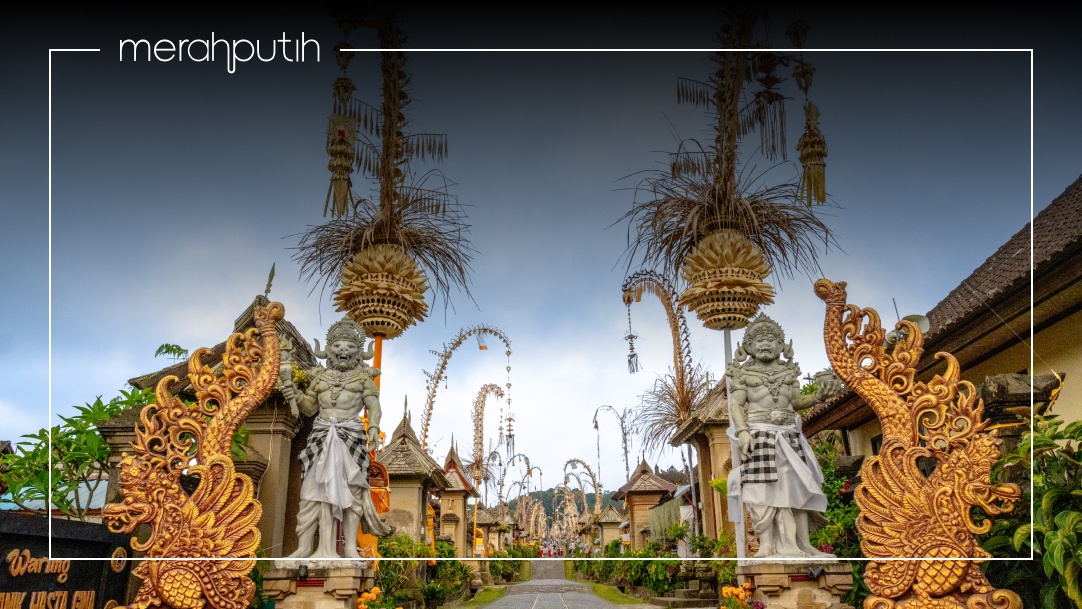Bali’s religious Hindu roots manifest in every aspect of Balinese daily life. Behind the beach clubs, yoga shalas, and cafes with a view, lies a people devoted to their faith and rituals. The island observes countless ceremonies and festivities, from daily offerings to large-scale annual affairs. Being in Bali for these celebrations is a unique, once in a lifetime experience.
Two of Bali’s major holidays are Galungan and Kuningan, celebrated twice a year within 10 days of each other. This sacred celebration is an integral part of the island’s culture.
What is Galungan?
Galungan is a traditional Balinese holiday that celebrates the triumph of good (Dharma) over evil (Adharma). For the Balinese, every sacred holiday is believed to be a time where the spirits of their ancestors come and visit. During Galungan, the ancestors are said to visit and stay in their homes for 10 days.
The legend behind Galungan celebrations
While today’s Galungan celebrations is symbolic of good over evil, the ancient folklore from which this holiday originated points to an original evil.
Legend has it that there was once a king that ruled over Bali and beyond. His name was Raja Mahadenawa, powerful beyond measure but evil beyond belief. He ran an oppressive regime, the kingdom suffered under his rule, and the people feared him.
Mahadenawa’s power got in his head. He believed himself to be a god and he forbade his people from worshiping other gods, destroying all the temples where religious ceremonies were held.
In the thick of Mahadenawa’s rule, a Balinese priest named Mpu Sangkul Putih meditated in the sacred Besakih Temple. He asked the gods to put an end to this king’s tyranny, and received guidance from the deities to ask for help from India.
After the Hindu people requested for help from their gods, their god of war Indra descended upon earth to take on and defeat Mahadenawa himself. The day of Indra’s victory is what is commemorated as Galungan.
- How is Galungan celebrated today?
Galungan is a moment for families to spend time together. Family units across all of Bali’s villages come together to prepare the various ceremonial objects and offerings for the sacred celebrations.
Penjor
You’ll know that Galungan is upon the island when the streets of Bali are lined with penjor. This is a traditional Balinese ornament that towers over everyone, made of curved bamboo poles and decorated with coconut leaves or janur. The penjor will also have flowers and other decorative elements attached.
The curve of the penjor is meant to symbolise the mountain of the most high gods from the legend of Galungan. The flowers signify the earth, a reminder of how every good thing comes from the gods.
Food offerings
Families also come together in the kitchen, where they spend days making food offerings for before, during, and after the main Galungan festivities.
Penyekeban
Three days before Galungan is penyekeban. This is a method of cooking that expedites the ripening of green bananas by covering them in clay pots.
Penyajaan
Other than bananas, Galungan also calls for fried rice cakes or jaja. These colourful delicacies are made of rice dough, prepared two days before, and are enjoyed together on the day of Galungan.
Penampahan
On the day before Galungan, swine and chickens are slaughtered for sacrifice in a ceremony called penampahan. The meat is then cooked to make food like lawar, which would then be served on Galungan.
Temple visit and prayer
After all the preparation comes the day of the festivities. On Galungan, Balinese families put on their traditional clothes and visit their village temples to pray together with family. All the food offerings prepared beforehand are brought to the temple and then enjoyed together.
More than just celebrating the victory of good over evil, this day is also a time to commemorate the Balinese’s long lineage and reconnect with each other.
Large family gatherings
The day after Galungan is a chance for extended families to visit. This means making the trip to other parts of Bali to their respective original villages. These family gatherings are a chance to spend time with the spirit of the ancestors during their stay.
How does Kuningan relate to Galungan?
Both Galungan and Kuningan go hand in hand. As aforementioned, it’s believed that the spirits of the ancestors come to stay for 10 days, after which they depart. This day is remembered as Kuningan, and serves as a welcome for Sang Hyang Widi, The Supreme God, coming to earth to bless mankind.
During Kuningan, families also make prayers and offerings known as banten. Kuning means “yellow,” hence why the banten includes yellow rice and other earthly produce to signify man’s gratitude to the gods.
As the celebrations for Galungan and Kuningan show, food is an integral part of Balinese culture. One way that you can celebrate this holiday while on the island is to explore Bali’s rich culinary offerings. From yellow rice to lawar, discover a taste of Galungan and Kuningan at Merah Putih Restaurant. Book a table today with exclusive gift vouchers to secure your seats.
FAQ
Galungan is a traditional Balinese holiday that celebrates the triumph of good (Dharma) over evil (Adharma). For the Balinese, every sacred holiday is believed to be a time where the spirits of their ancestors come and visit. During Galungan, the ancestors visit and stay in their homes for 10 days.
Galungan and Kuningan are major Balinese holidays that go hand in hand. While Galungan celebrates good over evil and the arrival of ancestral spirits in people’s homes, Kuningan is commemorated on the day the spirits depart, and is a day where Sang Hyang Widi, The Supreme God, come to give blessings to mankind.
Galungan preparations start days before the actual festivities. Family units across all of Bali’s villages come together to prepare the various ceremonial objects and offerings for the sacred celebrations, including making penjor and all the food to be offered at the temple.
During Kuningan, families also make prayers and offerings known as banten. Kuning means “yellow,” hence why the banten includes yellow rice and other earthly produce to signify man’s gratitude to the gods.



